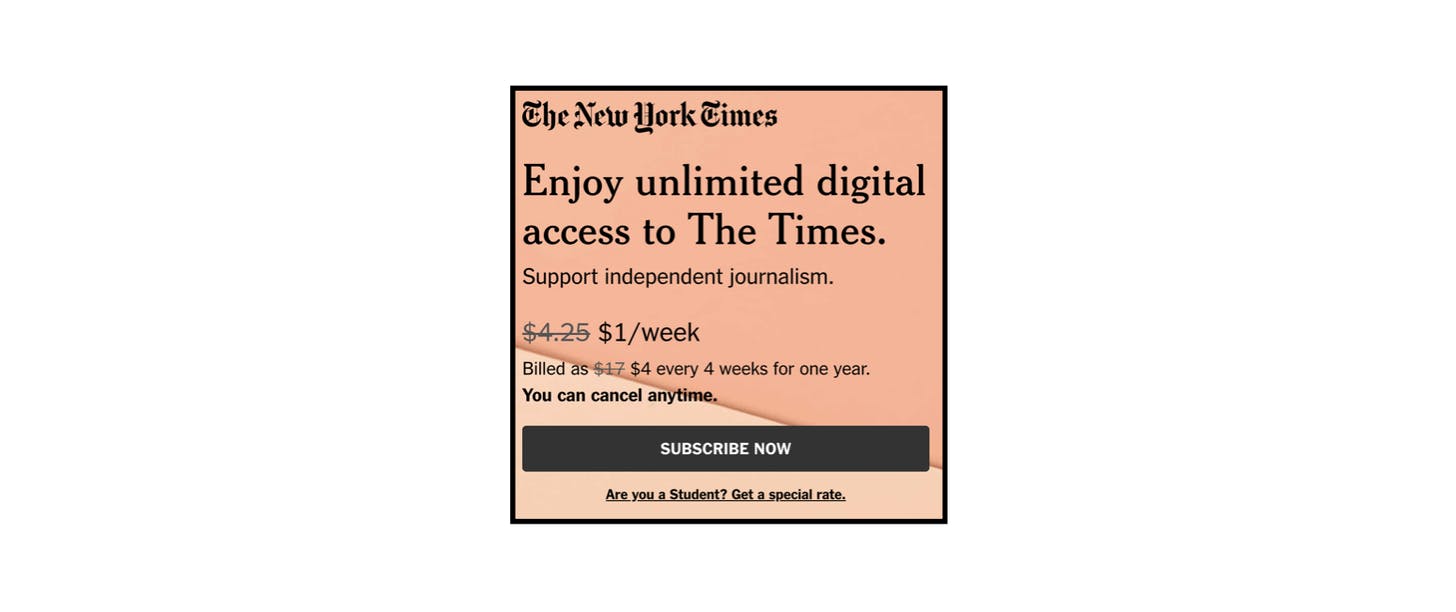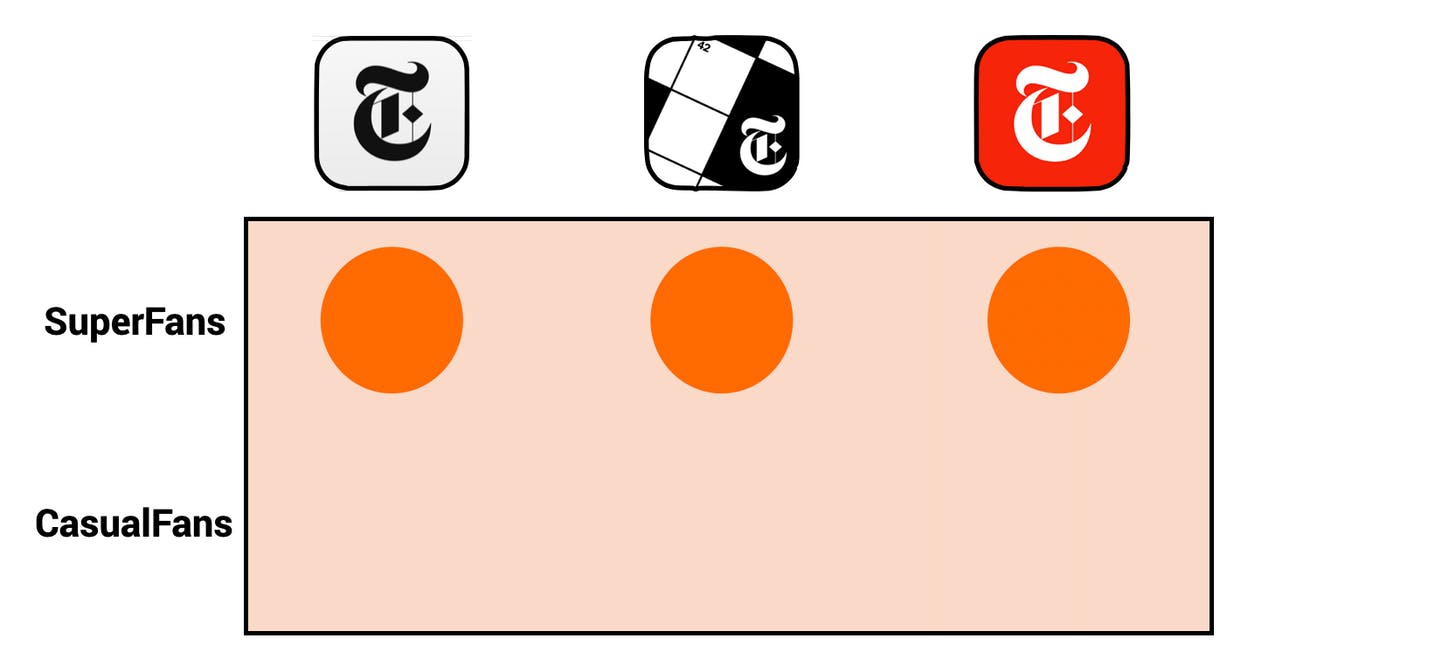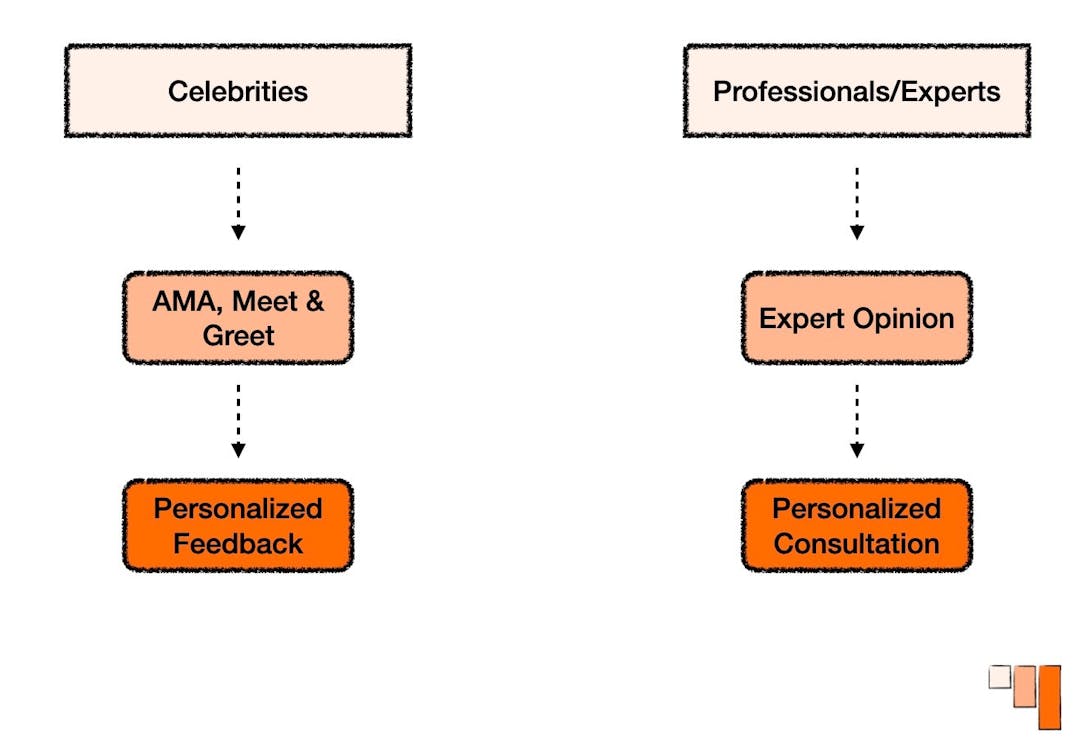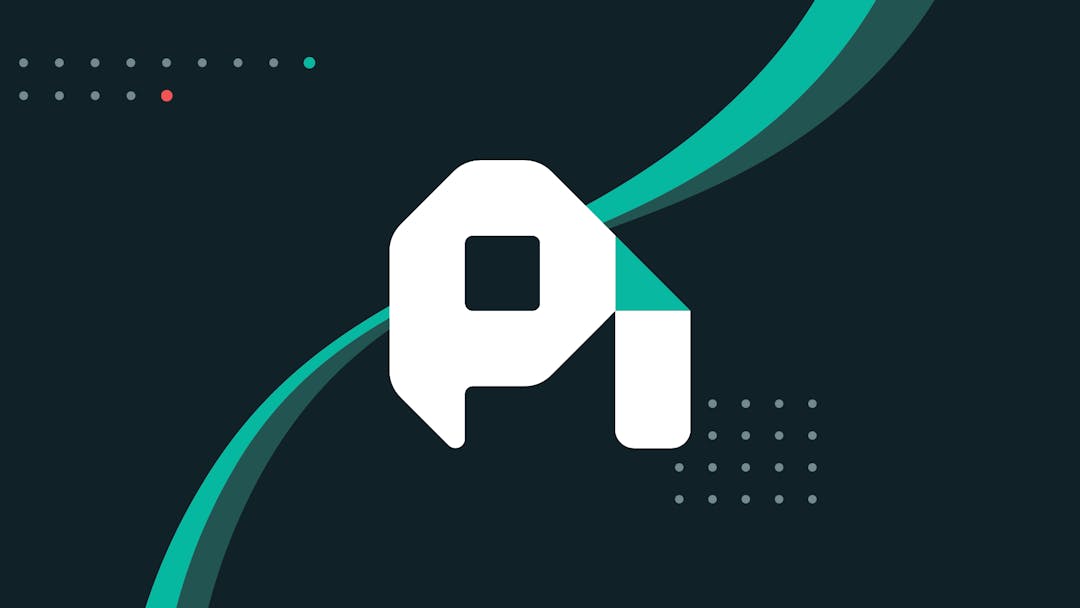Briefing
- The best bundles minimize SuperFan overlap and maximize CasualFan overlap. In practice, this means the best bundles have diverse products rather than similar products.
- A great example is The New York Times All-Access Bundle, which features 3 diverse products: News, Games, and Cooking.
- The All-Access Bundle is a powerful retention tool that allows the Times to grow accounts year over year. Because of this, the Times can fuel acquisition through aggressive promotions on their News product - giving them leverage over other publishers.
A couple months ago I subscribed to The New York Times.
Upon subscribing, I didn’t download the app and made no immediate plans to visit the website more frequently.
"Okay," you might be saying, “kind of a weird flex...why subscribe then?"
Honestly, they made me an offer I couldn’t refuse. Their recent promotion offers unlimited digital access at a ~76% discount to their typical subscription rate.

Considering how many NYT articles I get sent by friends and family, this price ($4 per month) was a no-brainer for me just to avoid hitting their paywall every month. A couple months in, I remain a happy passive subscriber.
Now, a key part of this promotion is that it’s only good for one year, and upon renewal, the price reverts to the original retail price of $17 per month. At that price, I can all but guarantee you that I will not be renewing.
However, the Times is not a typical publisher - they offer more than just news!
Today I want to talk about the Times bundling strategy, and how they can use it to hook a fickle subscriber like me for another year.
Let’s start with a quick primer on bundling.
Last week I mentioned a blog post by Shishir Mehrotra of Coda titled . My favorite concept from the piece is the idea of SuperFans and CasualFans.
Shishir defines a SuperFan as someone who is both willing to pay retail for a product and has the activation energy to find it. A CasualFan is someone who is missing one of these two criteria.
Shishir insists the best bundles minimize SuperFan overlap and maximize CasualFan overlap. In practice, this means bundles should contain diverse products rather than narrow ones.
I’ll use his visual to illustrate this point:

If you think about it, the more closely related two products are to each other, the more likely the same person is a SuperFan of both and would pay retail for each individually. If you bundle those two products at a lower price, you may be cutting into SuperFan revenue you would get for each product sold separately.
With this in mind, Shishir says the entire purpose of a bundle is unlocking CasualFan revenue, which is way more likely to happen if the products in the bundle are diverse.
[Editor’s Note: For further reading, I highly recommend Chris Dixon's classic piece on bundling using ESPN and History Channel as an example.]
Okay, so what’s this have to do with The New York Times?
When most people think about the Times, they probably think about the newspaper. However, the times actually has three paid product offerings. The other two are Games (centered around their famous Crossword puzzle) and Cooking, an index of thousands of recipes, and how-to guides. These three products are diverse enough to be a great candidate for bundling, and that’s exactly what the Times has done.
Riffing on one of Shishir’s visuals using the Times, the orange circles below represent SuperFan revenue that the Times would receive for each product offered a la carte. The peach background highlights the new possibilities when you activate CasualFan revenue with a bundled offer.

In his words (bold emphasis my own):
"The a-la-carte model clearly doesn’t maximize value, as consumers are getting access to fewer goods than they might be interested in, and providers are only addressing part of their potential market.
On the other hand, the bundled offer expands the universe and not only matches SuperFans with the products they are SuperFans of, but also allows for those consumers to get access to products of which they may be CasualFans. From a providers perspective, it gives access to consumers much beyond their natural SuperFan base."
So what does this look like in real life?
Here are retail prices for each of the Times’ products offered a la carte:
- Cooking: $40/year
- Games: $40/year
- News: $221/year
This comes out to a total of $301 per year for all 3 products.
However, in order to reach that total, one person would have to be a SuperFan of News, Games, and Cooking - which is rare. The Times understands this, which is why they offer the All-Access Bundle for $182 per year, a ~40% discount off the combined retail price.
[Editor’s Note: My mom is the rare exception - she loves NYT News, Cooking and is currently approaching a streak of 80 straight crosswords...]
The all-access bundle gives users unlimited access to News, Games, and Cooking, but the kicker is they also offer a free bonus subscription to a family member. This is genius because it doubles the likelihood that within the subscription, someone is a CasualFan of one of their three products.
Say you have a couple where one person loves crossword puzzles and the other is a casual newsreader. Rather than just getting the revenue from the crossword-lover, the New York Times can capture an additional $142 per year of CasualFan revenue that they wouldn’t be getting otherwise.
The All-Access bundle is a compelling offer for new subscribers upfront, but I believe it’s even more powerful as a retention tool.
Let’s tie this back to my subscription...
With the current promotion, I am paying $52 per year for Times news. If the Times was a typical publisher solely offering news, upon renewal, I would see the new price - $221 per year, and likely churn very quickly without being offered another incentive.
Perhaps they would offer a reduced discount, a practice SaaS companies do all the time, meeting somewhere in the middle between my original discount and retail price. This is doable, but unless they standardized the “meet-in-the-middle” rate, it would become challenging to offer one-off renewal discounts at the Times’ scale.
This is where the All-Access Bundle comes in…
Upon renewal, I’ll see that $221 price tag and push back immediately. That’s when the Times can say, well, instead of paying us $221 for just news, why don’t you pay us $182, and we’ll throw in Games, Cooking, and a bonus subscription for your wife.
All of a sudden, this higher fee doesn’t look as bad…
Not only do I get to keep my subscription, but my wife gets one too, and we both get access to more products. It just so happens that my wife is a CasualFan of Crosswords and Cooking - so this offer is actually something that could hook us for another year (and boost our ACV for the Times by 3.5x).
We’ll see if this is how the Times’ renewal flow plays out. Either way, their multi-product strategy gives the Times way more leverage than the typical publisher - making it possible to fuel acquisition with aggressive promotions like the one I signed up for.



